Supernova Remnants
The unprecedented broad bandwidth and excellent spectral resolution of ASCA has had a major impact on all areas of research into the nature of supernova remnants (SNRs). ASCA maps of SNRs in prominent X-ray emission lines and selected continuum bands show variation in temperature, ionization, chemical composition, and, indeed, even the nature of the underlying emission mechanism. Doppler shifts of bright X-ray lines have been used to directly measure the expansion speed of supernova ejecta. ASCA's increased sensitivity has allowed for a systematic study of the remnants in the Large Magellanic Cloud (LMC) leading to the discovery of new ejecta-dominated remnants and an independent measurement of the gas-phase abundances of the LMC. In some cases, ASCA spectroscopy of highly absorbed Galactic SNRs, which were weak and nondescript in previous soft X-ray observations, appear as remarkable objects with booming emission lines. These and other discoveries are leading to new insights into the nature of the ejecta of young remnants, the physics of supernova-induced shock waves, and the discovery and study of pulsar-powered synchrotron nebulae.Cosmic ray acceleration
ASCA spectro-imaging observations (Koyama et al. 1995 Nature 378, 255) have solved the long-standing mystery of the nature of SN1006 through the discovery of the expected emission lines from shock-heated SN ejecta and the localization of the previously known featureless power-law X-ray emission to the bright rims of the remnant. The nonthermal rim emission has been interpreted as synchrotron emission from electrons with energies up to 100 TeV accelerated in the remnant blast wave (Reynolds 1996 ApJ 459, L13) thereby providing the first clear link between particle acceleration at SN shock fronts and high-energy cosmic rays in the Galaxy.Non-thermal X-ray Emission
Nonthermal X-ray emission also occurs in pulsar-powered synchrotron nebula like the Crab Nebula. In the past, these types of remnants (which are also referred to as plerions) have been ``identified'' morphologically through their centrally peaked X-ray and radio images; however, this method is highly unreliable. The only secure way to identify a Crab-like remnant (in the absence of discovering the central pulsar) is by detecting its spatially-extended featureless power-law X-ray emission. The task of identification is further complicated by the occasional presence of thermal X-ray emission from the SN blast wave which may accompany the plerionic emission in the so-called ``composite'' remnants. As the major probe of the integrated current energy output of the pulsar, X-ray studies of synchrotron nebulae over a range of luminosities can provide crucial information on the nature and evolution of the central pulsar as well as on the dynamics of the remnant.In several situations now, ASCA has been able to identify and study plerions in SNRs both with and without known radio pulsars. Kes 73 and Kes 75 are two such examples observed during the PV phase which show a clear composite nature. Based on the observed emission lines in the thermal component, Helfand (1994 New Horizons meeting) has argued that Kes 73 fits nicely into the standard picture which has these objects originating in Type II SN events, while Kes 75 may be something quite different, perhaps even the accretion-induced collapse of a white dwarf. More recently Vasisht et al. (1996 ApJ 456, L59) used ASCA to detect a plerion in the young SNR G11.2-0.3, which is believed to be the counterpart to the historical supernova of AD 386. Combining the X-ray and radio data, Vasisht et al. derived an anomalously high plerion magnetic field (roughly 10 times the value in the Crab Nebula), which would suggest that the (as yet undetected) central pulsar has transfered much of its spin-down energy to the plerion in the form of magnetic fields ! A more careful look at evolutionary scenarios for this remnant (Bandiera, Pacini, & Salvati 1996 ApJ in press) argues that a high magnetic field is not required if one considers the dynamical evolution of the nebula under the influence of the external shell. Other suspected remnants of this type, such as CTA-1 (Slane et al. 1996 in preparation) and MSH 11-62 (Harrus, Hughes, & Slane 1996 in preparation), also clearly show a composite nature in recent observations by ASCA.
In contrast to G11.2-0.3, W44 does contain a radio pulsar (the 267 ms period PSR B1853+01) and therefore was expected to show an X-ray synchrotron nebula with a luminosity of ~ 8 x 10^32 ergs/s . Figure 7 shows the ASCA images of W44 from the GIS and SIS in two energy bands (Harrus, Hughes, & Helfand 1996 ApJ in press). At soft X-ray energies W44 is a reasonably bright thermal source and no emission from the pulsar or its nebula is evident. At harder energies, as the lower pair of images shows, the thermal emission has faded and the power-law emission of the synchrotron nebula is revealed. Estimates of the magnetic field in this plerion (70 microGauss) are consistent with other plerionic SNRs of comparable luminosity. As the oldest synchrotron nebula yet detected, W44 stands to aid considerably in our attempts to understand the interaction of pulsar relativistic winds with their environments.
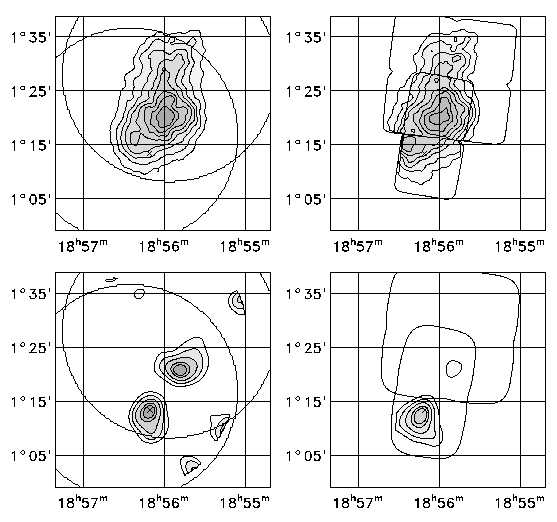
Figure 7. ASCA images of the supernova remnant W44 from the GIS (left panels) and the SIS (right panels). The low energy band (upper pair: 0.5-4.0 keV) show the thermal X-ray emission from the remnant and is very similar to that observed previously by Einstein and ROSAT. In the high energy band (lower pair: 4.0-9.5 keV) the remnant is not visible and only a few unresolved sources appear. The most significant of these is coincident with the position of the radio pulsar PSR B1853+01, which is indicated by the cross.
ASCA has also revealed the neutron star candidate in the SNR RCW 103, originally suggested by a 16-year-old Einstein HRI observation. The hard-band ASCA (> 3 keV) image of this young shell-type SNR reveals the unresolved point source which is otherwise obscured by thermal shock emission from the nebula (Gotthelf et al. 1996, HEAD meeting; Figure 8).
ASCA has also revealed the neutron star candidate in the SNR RCW 103, originally suggested by a 16-year-old Einstein HRI observation. The hard-band ASCA (> 3 keV) image of this young shell-type SNR reveals the unresolved point source which is otherwise obscured by thermal shock emission from the nebula (Gotthelf et al. 1996, HEAD meeting; Figure 8).
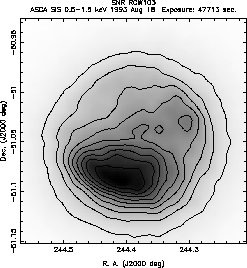
ASCA has also revealed the neutron star candidate in the SNR RCW 103, originally suggested by a 16-year-old Einstein HRI observation. The hard-band ASCA (> 3 keV) image of this young shell-type SNR reveals the unresolved point source which is otherwise obscured by thermal shock emission from the nebula (Gotthelf et al. 1996, HEAD meeting; Figure 8).
ASCA has also revealed the neutron star candidate in the SNR RCW 103, originally suggested by a 16-year-old Einstein HRI observation. The hard-band ASCA (> 3 keV) image of this young shell-type SNR reveals the unresolved point source which is otherwise obscured by thermal shock emission from the nebula (Gotthelf et al. 1996, HEAD meeting; Figure 8).

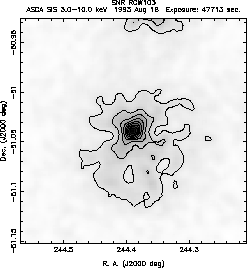
Figure 8. Exposure corrected ASCA SIS images of the SNR RCW103 in two spectral bands. The shell-type SNR remnant is apparent in the soft band (0.5-3.0 keV) image (left), but disappears in the hard band (3.0-12.8 keV) image (right), which reveals the neutron star candidate.
Thermal X-ray Emission
As exciting as these preceding results are, the most spectacular results on SNRs have come, arguably, from remnants showing thermal spectra. The richness of ASCA spectra is perhaps best exemplified by the fabulous spectrum of W49B (Figure 9: Fujimoto et al. 1995 PASJ 47, L31), which shows He- and H-like K-alpha transitions of the astrophysically abundant elements Si, S, Ar, Ca, and Fe. Ratios of these lines, which provide accurate constraints on the ionization state and electron temperature of the plasma, require that the remnant be composed of multiple components, an effect that was also seen in the ASCA spectrum of the young oxygen-rich SNR E0102 in the Small Magellanic Cloud (Hayashi et al. 1994 PASJ 46, L121). For W49B, the complex plasma conditions indicated by the spectrum are reinforced by the SIS maps which show a shell-like structure in the light of Si and S line emission surrounding an interior region of mostly Fe emission, providing the first clear evidence for stratification in the ejecta of this young remnant.
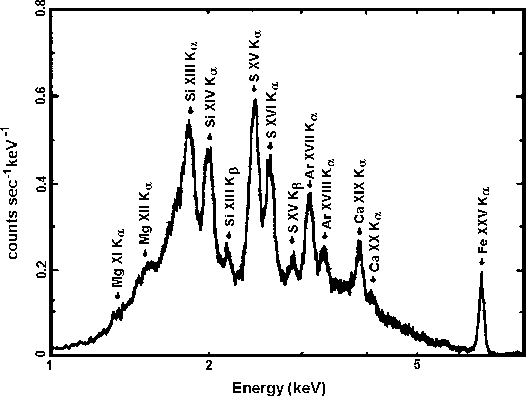
Figure 9. The SIS energy spectrum of the supernova remnant W49B. The He- and H-like K-alpha transitions of the most abundant elements are indicated.
ASCA observations of Tycho's SNR (Hwang & Gotthelf 1996 ApJ submitted) have revealed dramatic evidence for chemical inhomogeneities in this young remnant of a Type Ia SN explosion, although the composition does not appear to be radially stratified in a well-ordered manner. Holt et al. (1994 PASJ 46, L151) used the ASCA SIS data of Cas A to produce a velocity map from the doppler shift of the Si He-like K-alpha line, which confirmed the SNR expansion velocities of 1000 km/s determined by previous Einstein observations (Markert et al. 1983 ApJ 268, 134).
LMC remnants
ASCA has also made a systematic study of the SNRs in the LMC. One of the early results of this project was the discovery of new ejecta-dominated remnants of Type Ia SNe (Hughes et al. 1995 ApJ 444, L81). This work showed how it was possible to determine the type of the SN explosion from a comparison of the ASCA X-ray spectra of the remnant with the nucleosynthetic yields expected from Type Ia and II SNe. One of the surprising conclusions from this work was that roughly one-half of the SNRs produced in the LMC within the last ~1500 yrs came from Type Ia SNe. The fraction expected based on extragalactic patrols is more like 10%-20%. Hayashi et al. (1996 in preparation) have determined the abundances of the astrophysically common elements O, Ne, Mg, SI, S, and Fe, using ASCA data on the older LMC SNRs whose emission is dominated by swept-up interstellar medium (ISM). The X-ray-derived values are consistent with those from optical studies (Russell & Dopita 1992 ApJ 384, 508), but the X-ray data provide significantly more accurate measurements of the important species Mg and Si (for which few good emission lines in the optical band exist). Since the ISM contains the integrated sum of material lost by stars in winds and SNe over the galaxy's life, the chemical composition is one of the principle probes of the galaxy's star formation history.ASCA also has the ability to analyze quite complex regions such as 30 Doradus, which contains several SNRs including N157b, N157c and SN1987a, embedded within the OB association LH99. Figure 10 contrasts the soft (< 1.5 keV) diffuse thermal emission from a hot X-ray superbubble (top), with the hard non-thermal point-like emission seen from N157b (bottom), consistent with an unseen pulsar (Gotthelf \& Wang, 1995, Wurzburg).
ASCA also has the ability to analyze quite complex regions such as 30 Doradus, which contains several SNRs including N157b, N157c and SN1987a, embedded within the OB association LH99. Figure 10 contrasts the soft (< 1.5 keV) diffuse thermal emission from a hot X-ray superbubble (top), with the hard non-thermal point-like emission seen from N157b (bottom), consistent with an unseen pulsar (Gotthelf \& Wang, 1995, Wurzburg).
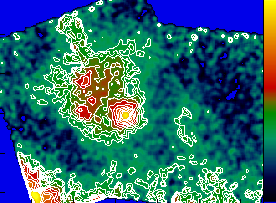 ASCA has also made a systematic study of the SNRs in the LMC. One of
the early results of this project was the discovery of new
ejecta-dominated remnants of Type Ia SNe (Hughes et al. 1995 ApJ 444,
L81). This work showed how it was possible to determine the type of the SN
explosion from a comparison of the ASCA X-ray spectra of the remnant
with the nucleosynthetic yields expected from Type Ia and II SNe. One
of the surprising conclusions from this work was that roughly one-half
of the SNRs produced in the LMC within the last ~1500 yrs came
from Type Ia SNe. The fraction expected based on extragalactic
patrols is more like 10%-20%. Hayashi et al. (1996 in preparation)
have determined the abundances of the astrophysically common elements O,
Ne, Mg, SI, S, and Fe, using ASCA data on the older LMC SNRs whose
emission is dominated by swept-up interstellar medium (ISM). The
X-ray-derived values are consistent with those from optical studies
(Russell & Dopita 1992 ApJ 384, 508), but the X-ray data provide
significantly more accurate measurements of the important species Mg
and Si (for which few good emission lines in the optical band exist).
Since the ISM contains the integrated sum of material lost by stars in
winds and SNe over the galaxy's life, the chemical composition is one
of the principle probes of the galaxy's star formation history.
ASCA has also made a systematic study of the SNRs in the LMC. One of
the early results of this project was the discovery of new
ejecta-dominated remnants of Type Ia SNe (Hughes et al. 1995 ApJ 444,
L81). This work showed how it was possible to determine the type of the SN
explosion from a comparison of the ASCA X-ray spectra of the remnant
with the nucleosynthetic yields expected from Type Ia and II SNe. One
of the surprising conclusions from this work was that roughly one-half
of the SNRs produced in the LMC within the last ~1500 yrs came
from Type Ia SNe. The fraction expected based on extragalactic
patrols is more like 10%-20%. Hayashi et al. (1996 in preparation)
have determined the abundances of the astrophysically common elements O,
Ne, Mg, SI, S, and Fe, using ASCA data on the older LMC SNRs whose
emission is dominated by swept-up interstellar medium (ISM). The
X-ray-derived values are consistent with those from optical studies
(Russell & Dopita 1992 ApJ 384, 508), but the X-ray data provide
significantly more accurate measurements of the important species Mg
and Si (for which few good emission lines in the optical band exist).
Since the ISM contains the integrated sum of material lost by stars in
winds and SNe over the galaxy's life, the chemical composition is one
of the principle probes of the galaxy's star formation history.
ASCA also has the ability to analyze quite complex regions such as 30 Doradus, which contains several SNRs including N157b, N157c and SN1987a, embedded within the OB association LH99. Figure 10 contrasts the soft (< 1.5 keV) diffuse thermal emission from a hot X-ray superbubble (top), with the hard non-thermal point-like emission seen from N157b (bottom), consistent with an unseen pulsar (Gotthelf \& Wang, 1995, Wurzburg).
ASCA also has the ability to analyze quite complex regions such as 30 Doradus, which contains several SNRs including N157b, N157c and SN1987a, embedded within the OB association LH99. Figure 10 contrasts the soft (< 1.5 keV) diffuse thermal emission from a hot X-ray superbubble (top), with the hard non-thermal point-like emission seen from N157b (bottom), consistent with an unseen pulsar (Gotthelf \& Wang, 1995, Wurzburg).

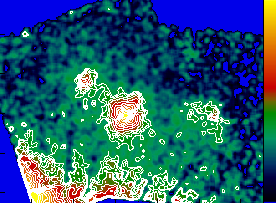
Figure 10. Left: the < 1.5 keV image of the 30 Doradus region. Right: the > 1.5 keV image. The radial strips, most apparent in the hard image, are stray light artifacts from nearby X-ray bright LMC X-1.
Rotation Powered Pulsars
ASCA has made the first hard X-ray (2-5 keV) detection of Geminga, a radio quiet, rotation-powered neutron star with a period of 0.237 seconds. Figure 11 shows the pulse profile in the 1-4 keV band from the combined GIS 2 and GIS 3 data (Halpern & Wang, in preparation).
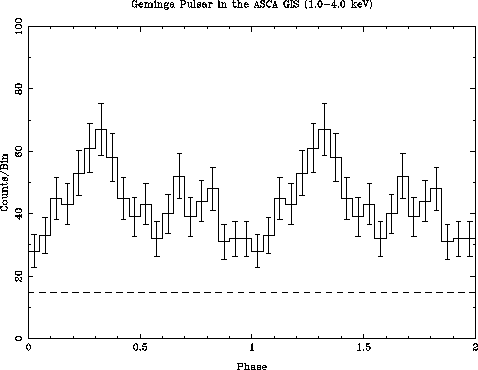
Figure 11. The pulse profile of Geminga in the 1-4 keV band from combined GIS 2 and GIS 3 data.
The dashed line is an indication of the background level, showing that the pulsar emission is highly modulated with a pulsed fraction of ~ 40%.
Previous soft X-ray observations of the Geminga pulsar with ROSAT revealed a two-component spectrum. In addition to a blackbody of T ~ 5 x 10^5 K coming from the neutron star surface, a much weaker and harder component was present whose origin was unclear. Both a power law and and a higher temperature blackbody fitted the hard component, and neither was preferred over the other. These two alternatives would have required completely different explanations. If thermal, the hard component would have to be interpreted as a small, hot polar cap of T ~ 3 x 10^6 K. But if nonthermal, it would be synchrotron emission from the pulsar magnetosphere. Unfortunately, the statistics of the ROSAT pulse profile above 1 keV were insufficient to help resolve this mystery.
But now, the ASCA detection clearly demonstrates the nonthermal nature of Geminga's hard X-rays. A blackbody would have contributed negligible flux above 2 keV. Instead, the ASCA spectrum is best fitted with a power law of photon index ~ 2.0 +/- 0.5 up to 5 keV. Although this is only a crude parameterization with no clear physical basis, it is in agreement with an extrapolation of the ROSAT hard component. Also significant is the shape of the hard X-ray pulse. Unlike the soft ROSAT light curve, which consists of a broad, single pulse, the ASCA light curve is sharper, and seems to have two peaks. The sharpness of the pulse is compelling consistency argument in favor of emission by relativistic particles. (Although nonthermal, the ASCA spectrum does not extrapolate to the EGRET high-energy gamma-ray band, which therefore represents a third and energetically dominant component.) It is speculated that the high-energy gamma-rays are curvature radiation from the ``primary'' electron-positron pairs produced in the magnetosphere accelerator, while the X-rays are synchrotron emission from ``secondary'' pairs.
This sort of analysis is possible for several of the intermediate-age, rotation-powered pulsars which have similar multicomponent ROSAT spectra. Greiveldinger et al. (1996 ApJ in press) use combined ROSAT and ASCA spectra of PSR 1055-52 and PSR 0656+14 to show that the X-ray emission has at least three components, from the neutron star surface, from the polar cap, and from the magnetosphere.
Last modified: Tuesday, 26-Jun-2001 14:22:33 EDT
If you have any questions concerning ASCA, visit our Feedback form.

